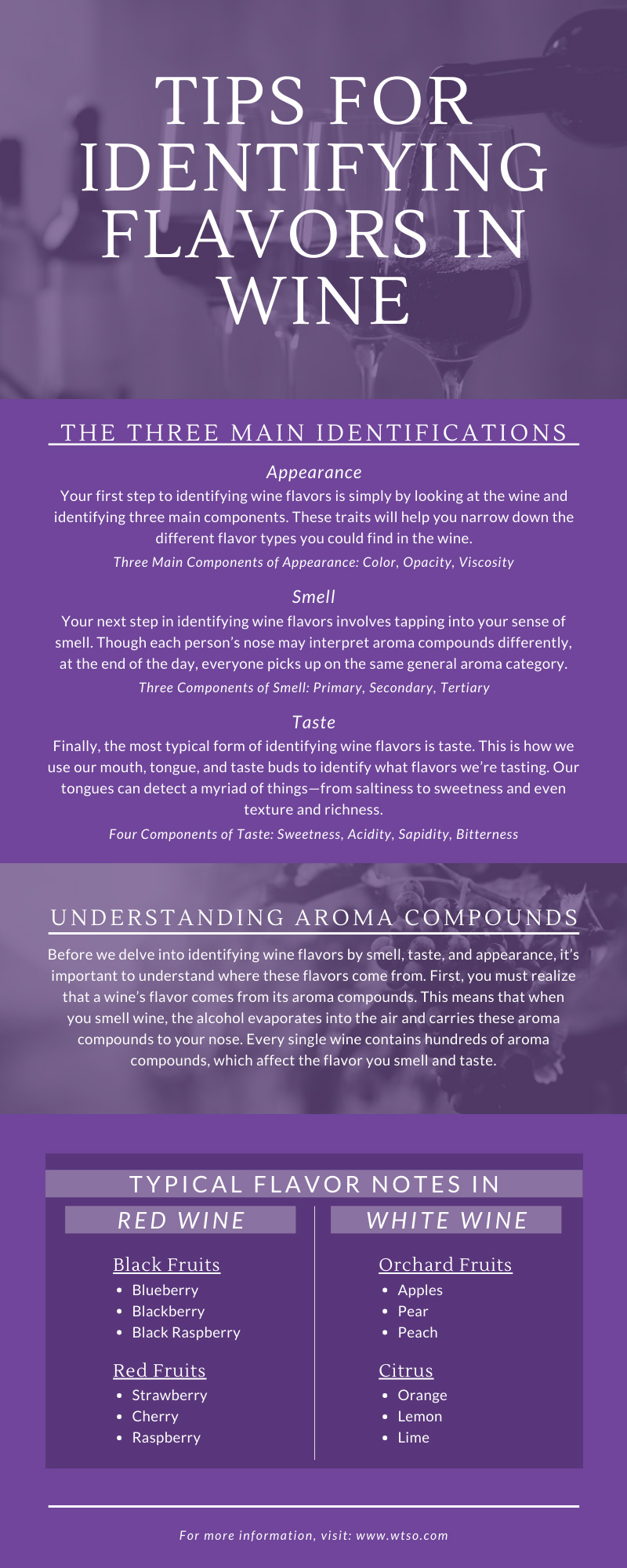People all over the world love wine. They love the tingle it brings to their lips, the freedom it brings to their speech, and the love that permeates from its body. The truth is, you don’t have to be a wine expert to feel those things. You also don’t have to be a wine expert to understand which wines and their flavors make you feel that tingle the most. In fact, with a few simple tips for identifying flavors in wine, even the most beginner wine-lovers can determine which bottle of wine will fit their needs for the night. If that’s something you’re interested in, then take a look below at the three main ways to identify flavors in wine.
Understanding Aroma Compounds
Before we delve into identifying wine flavors by smell, taste, and appearance, it’s important to understand where these flavors come from. First, you must realize that a wine’s flavor comes from its aroma compounds. This means that when you smell wine, the alcohol evaporates into the air and carries these aroma compounds to your nose. Every single wine contains hundreds of aroma compounds, which affect the flavor you smell and taste.
Just one aroma compound can initiate various responses in your brain. For example, one fruit flavor may signify that fruit, but it can also waft floral notes. Since these fruity notes tend to be the easiest to comprehend, we’ll begin by noting some of the typical fruit flavor notes you can find in both red and white wine.
Typical Flavor Notes in Red Wine
Black Fruits
- Blueberry
- Blackberry
- Black Raspberry
- Black Cherry
- Black Raisins
- Açaí
- Fig
- Prune
- Black Currant
- Black Plum
Quick Note: Wines with black fruits, such as Cabernet Sauvignon and Syrah, are typically fuller-bodied.
Red Fruits
- Strawberry
- Cherry
- Raspberry
- Goji Berry
- Cranberry
- Pomegranate
- Red Plum
- Dragon Fruit
Quick Note: You’ll find that red wine blends combine red and black fruit flavors—this can help you determine which wines were used to create the blend.
Typical Flavor Notes in White Wine
Orchard Fruits
- Apples: red, green, yellow, and baked
- Pear
- Peach
- White peach
- Apricot
- Nectarine
Citrus
- Orange
- Lemon: lemon meringue, lemon zest, and Meyer lemon
- Lime: lime zest, key lime
- Passion fruit
- Red grapefruit
- Pink grapefruit
Quick Tip: You’ll quickly realize that the flavors of the same type of wine will depend on where it was made. A Chenin Blanc from South Africa, for example, may showcase more peach and lemon flavors, whereas one from France may showcase more lime and green apple. This all has to do with the climate.
The Three Main Identifications
Now that we’ve explained the different fruit flavor notes in wine, we’ll delve into the three main ways to identify flavors: smell, appearance, and taste. Before you become fraught with anxiety, remember to take it slow—no wine connoisseur recognized all the wine flavors with their first sip. The more knowledgeable you are about the typical flavors found in wine, the better you’ll be at recognizing and identifying flavors in a variety of wines.
Appearance
Your first step to identifying wine flavors is simply by looking at the wine and identifying three main components. These traits will help you narrow down the different flavor types you could find in the wine.
Three Main Components of Appearance:
- Color: Your first step is to look at the color. How deep of a red is it? How yellow of a white? These will all help you identify flavors later.
- Opacity: You should also take note of how opaque or transparent the wine is. This will be the key factor to identifying whether you’re dealing with a light- or full-bodied wine.
- Viscosity: The last component to look for in appearance deals with the viscosity. This may seem a bit more difficult to understand for newer wine-drinkers (especially in regard to how it relates to flavor), but it simply refers to how thick or watery the wine is. Sweeter wines generally have higher viscosity, which means they have a thicker consistency.
Smell
Your next step in identifying wine flavors involves tapping into your sense of smell. Though each person’s nose may interpret aroma compounds differently, at the end of the day, everyone picks up on the same general aroma category. For example, one person may smell strawberry while another smells raspberry, but the general consensus is that the aroma is of berries in the red fruit category. You can divide the smell—or nose—of the wine into three primary components, which you’ll find below.
Three Components of Smell:
- Primary: These smells are the easiest to recognize, consisting mostly of herb and spice scents, floral notes, and the fruit flavors we mentioned above.
- Secondary: Secondary aromas are the smells that come from various winemaking processes and practices. These secondary smells are easier to spot in white wines, and they’ll most often derive from yeast—meaning cheeses, stale beer, or nuts.
- Tertiary: Lastly, tertiary aromas result from the aging process, whether in the bottle or in oak. Most tertiary smells are savory—this is where those phrases such as “old tobacco,” “cured leather,” and “cedar” come into play.
Taste
Finally, the most typical form of identifying wine flavors is taste. This is how we use our mouth, tongue, and taste buds to identify what flavors we’re tasting. Our tongues can detect a myriad of things—from saltiness to sweetness and even texture and richness. Generally speaking, humans can recognize four basic flavors, and all of these are quintessential to determining the flavor of a wine.
Four Components of Taste:
- Sweetness: Sweetness results from the grapes used to create the wine. This sweetness helps us determine what sort of flavors we’re tasting, such as the fruity flavor of berries.
- Acidity: On the opposite side of the spectrum is acidity. Think of this as a freshness in your mouth that creates a rush of salivation. You’ll notice that more acidic flavors tend to include citrusy fruits such as lemon, lime, orange, and grapefruit.
- Sapidity: This is a bit more difficult for newer wine-lovers to identify, but it plays a large role in the overall flavor of the wine. The flavors of a sapid wine highlight minerality and salinity due to the mineral salts dissolved in the liquid.
- Bitterness: The last component that our tongue can recognize is bitterness. This is most often caused by tannins, and it will dry out your mouth and teeth. Flavors such as tobacco and cured leather most often partner with bitterness.
By following these steps and knowing some typical flavors, you’ll be that much closer to identifying a variety of flavors in your own wines. To improve your identification skills, turn to Wines ’Til Sold Out, your favorite online wine sellers with a wide variety of choices. Our weekly tastings will get you that much closer to being a true wine connoisseur—and Wine Enthusiast Magazine would agree!




